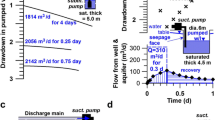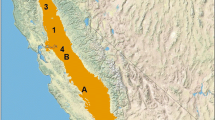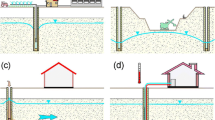Abstract
This paper presents new findings in interpreting analytical solutions of steady radial flow to a well in a semi-confined aquifer (overlain by a phreatic aquifer and aquitard), and demonstrates that 95% of pumped water is derived from leakage water within a radius of 4 times the leakage factor. The travel times of the leakage water from the radii of influence to the well are usually much longer than those derived from the travel time criteria currently used to delineate the well protection areas. The delineation of well protection zones based on the travel time criteria will not properly protect the source of water to the well. Therefore, the percentage of leakage water to the well is used as a new criterion to define the well protection areas. Within each well protection area, the mean residence time is used as an indicator of the renewable period of the aquifer system. Leakage-rate weighted residence times are used to calculate the mean residence time. For the safety and sustainability of drinking water supplies, groundwater in the phreatic aquifer within the radius of influence should be protected.
Résumé
Cet article présente de nouvelles découvertes dans l’interprétation de solutions analytiques au calcul du flux radial permanent d’un puits dans un aquifère semi-captif (surmonté par un aquifère libre et aquitard), et démontre que 95 % de l’eau pompée provient de drainance sur un rayon de 4 fois le facteur de drainance. Les temps de transfert drainance suivant les rayons d’appel du puits sont habituellement beaucoup plus longs que ceux déduits des critères temps de transfert actuellement retenus pour délimiter les périmètres de protection de puits. Le tracé des périmètres de protection basés sur le critère temps de transfert ne protègeront pas correctement la ressource du puits. C’est pourquoi on utilise le facteur drainance comme nouveau paramètre pour définir les périmètres de protection du captage. Pour chaque périmètre de protection, le temps de séjour moyen est utilisé comme indicateur de la période de renouvellement du système aquifère. Les temps de séjour pondérés par le facteur drainance sont utilisés pour calculer le temps de séjour moyen. Pour la sécurité et la pérennité de l’approvisionnement en eau potable, l’aquifère devrait être protégé sur le rayon d’appel.
Resumen
Este trabajo presenta nuevos hallazgos para interpretar las soluciones analíticas de flujo estacionario radial hacia un pozo en un acuífero semiconfinado (cubierto por un acuífero freático y acuitardo), y demuestra que el 95% del agua bombeada proviene del agua de filtración dentro de un radio de 4 veces del factor de filtración. Los tiempos de tránsito del agua de filtración desde el radio de influencia al pozo son usualmente de mucho mayores que aquellos provenientes de los criterios de tiempo de tránsito corrientemente usados para delinear las áreas de protección de los pozos. El delineado de la zona de protección de los pozos basado en los criterios de tiempo de tránsito no protegen adecuadamente la fuente de agua hacia el pozo. Por lo tanto, el porcentaje de agua de filtración hacia el pozo es usado como un nuevo criterio para definir las áreas de protección del pozo. Dentro de cada área de protección del pozo se usa el tiempo de residencia media como un indicador del período de renovación del sistema acuífero. Los tiempos de residencia ponderados con el ritmo de filtración son usados para calcular el tiempo medio de residencia. Para la seguridad y sustentabilidad de los abastecimientos de agua potable, el agua subterránea se debe proteger en el acuífero freático dentro del radio de influencia.
摘要
本文对越流含水层向井流稳定流解析解进行了新的解译, 发现流向开采井的95%的越流量来自于半径为越流因子4倍的范围之内, 这个半径可以称为影响半径。越流水流从影响半径流到开采井的时间一般要大于通常用于划分水源保护区用的滞流时间标准。所以, 只用滞流时间标准划分水源保护区不能够完全保护流向开采井的水源, 因而建议把流向开采井的越流量占开采量的百分比作为一个新的划分水源保护区的标准。在水源保护区内, 平均滞流时间可以作为含水层更新的时间尺度。文章给出了用越流量加权滞流时间计算平均滞流时间的方法。为了长期安全和可持续供水, 影响半径内潜水含水层中的地下水应当得到保护。
Resumo
Este trabalho apresenta novas descobertas na interpretação de soluções analíticas de fluxo radial constante para um poço num aquífero semiconfinado (coberto por um aquífero livre e aquitardo), e demonstra que 95% da água bombeada é derivada do escoamento de água num raio de 4 vezes o fator de escoamento. O tempo de percolação do escoamento desde o raio de influência até ao poço é geralmente muito maior do que o derivado dos critérios do tempo de percolação usado atualmente para delinear as áreas de proteção das captações. A delimitação de zonas de protecção de captações com base nos critérios de tempo de percolação não irão proteger adequadamente a origem de água para o poço. Portanto, a percentagem de escoamento de água para o poço é utilizada como um novo critério para definir as áreas de protecção. Dentro de cada zona de protecção do poço, o tempo médio de residência é usado como um indicador do período renovável do sistema aquífero. A taxa de escoamento ponderada dos tempos de residência é usada para calcular o tempo médio de residência. Para segurança e sustentabilidade do abastecimento de água potável, a água subterrânea do aquífero freático dentro do raio de influência deve ser protegida.







Similar content being viewed by others
References
Anton H (1999) Calculus: a new horizon, 6th edn. New York, Wiley, pp 324–327
Bogue KV (1994) Evaluation of wellhead protection models: a case study, Xenia, Ohio. MSc Thesis. Wright University, Ohio
Braunsfurth AC, Schneider W (2008) Calculating groundwater transit time of horizontal flow through leaky aquifers. Ground Water 46(1):160–163
Butler Jr JJ, MS Tsou (2003) Pumping-induced leakage in a bounded aquifer: an example of a scale-invariant phenomenon. Water Resour Res 39(12):1344. doi:10.1029/2002WR001484.
Chave PG, J Howard, J Schijven, S Appleyard, F Fladerer, W Schimon (2006) Groundwater protection zones. In: Schmoll O, Howard G, J Chilton, Chorus I (eds) Protecting groundwater for health: managing the quality of drinking-water sources. IWA, London, UK
Cheng AHD, Morohunfola OK (1993) Multilayered leaky aquifer systems, I: pumping well solutions. Water Resour Res 29:2787–2800
De Glee GJ (1930) Over grondwaterstroomingen bij wateronttrekking door middel van putten [Groundwater flow by abstraction through wells]. Thesis, TU Delft, The Netherlands, 175 pp
De Vries JJ (2006) Early developments in groundwater research in The Netherlands: a societally driven science. In: T Tvedt, Oestigaard T (eds) A history of water, the world of water, Tauris, London, pp 185–206
Hantush MS (1956) Analysis of data from pumping tests in leaky aquifers. Trans Am Geophys Union 37(6):702–714
Hantush MS (1960) Modification of the theory of leaky aquifers. J Geophys Res 65:3713–3725
Hantush MS (1964) Hydraulics of wells. In: Chow VT (ed) Advances in hydroscience. Academic, New York
Hantush MS, Jacob CE (1955) Non-steady radial flow in an infinite leaky aquifer. Trans Am Geophys Union 36:95–100
Hemker CJ (1984) Steady groundwater flow in leaky multiple-aquifer systems. J Hydrol 72:355–374
Hemker CJ (1985) Transient well flow in leaky multiple-aquifer systems. J Hydrol 81:111–126
Hemker CJ, Maas C (1987) Unsteady flow to wells in layered and fissured aquifer systems. J Hydrol 90:231–249
Hunt B (1985) Flow to a well in a multiaquifer system. Water Resour Res 21:1637–1641
Jacob CE (1946) Radial flow in a leaky artesian aquifer. Trans Am Geophys Union 27:198–205
Kazemi G, J Lehr, P Perrochet (2006) Groundwater age, Wiley, New York, 325 pp
Kooper J (1914) Beweging van het water in den bodem bij onttrekking door bronnen (in Dutch). Ingenieur 29(697–706):710–716
Kruseman GP, NA de Ridder (1994) Analysis and evaluation of pumping test data. Completely revised 2nd edn. ILRI Publication 47. International Institute for Land Reclamation and Improvement, Wageningen, The Netherlands
Landmeyer JE (1994) Description and application of capture zone delineation for a wellfield at Hilton Head Island, South Carolina. US Geol Surv Tech Water Resour Invest Rep 94-4012
Maas C (1986) The use of matrix differential calculus in problems of multiple-aquifer flow. J Hydrol 88:43–67
Maas C (1987a) Groundwater flow to a well in a layered porous medium 1: steady flow. Water Resour Res 23:1675–1681
Maas C (1987b) Groundwater flow to a well in a layered porous medium 2: nonsteady multiple aquifer flow. Water Resour Res 23:1683–1688
Motz LH (1990) Aquifer parameters from a one-dimensional steady-leaky type curve. Ground Water 28(3):350–356
Motz LH (1991) Aquifer parameters from constant discharge nonsteady-leaky type curves. Ground Water 29(2):181–185
Neuman SP, Witherspoon PA (1969) Applicability of current theories of flow in leaky aquifers. Water Resour Res 5:817–829
Simpson MJ, Clement TP, Yeomans FE (2003) Analytical model for computing residence times near a pumping well. Ground Water 41(3):351–354
US EPA (1987) Guidelines for delineation of wellhead protection areas. EPA/440/6-87-010. US EPA, Washington, DC, 212 pp
US EPA (1994) Handbook, groundwater and wellhead protection. EPA/625/R-94/001. US EPA, Washington, DC, 269 pp
Vandenberg A (1977) Type curves for analysis of pump tests in leaky strip aquifers. J Hydrol 33:15–26
Van Waegeningh HG (1981) A proposal for the dimensions of protection areas. Sci Total Environ 21:397–403
Verruijt A (1970) Theory of groundwater flow. MacMillan, London, 190 pp
Walton W (1962) Selected analytical methods for well and aquifer evaluation. Illinois State Water Surv Bull 49:1–81
Wu SY (1987) Steady ground-water flow through layered media. Transp Porous Media 2:103–127
Zhan H, Bian A (2006) A method of calculating pumping induced leakage. J Hydrol 328:659–667
Acknowledgements
The author is grateful for the constructive comments made by Editor Dr Vincent Post on an early version. The thoughtful reviews and useful comments from the anonymous Associate Editor and two reviewers helped further to improve the final manuscript.
Author information
Authors and Affiliations
Corresponding author
Rights and permissions
About this article
Cite this article
Zhou, Y. Sources of water, travel times and protection areas for wells in semi-confined aquifers. Hydrogeol J 19, 1285–1291 (2011). https://doi.org/10.1007/s10040-011-0762-x
Received:
Accepted:
Published:
Issue Date:
DOI: https://doi.org/10.1007/s10040-011-0762-x




